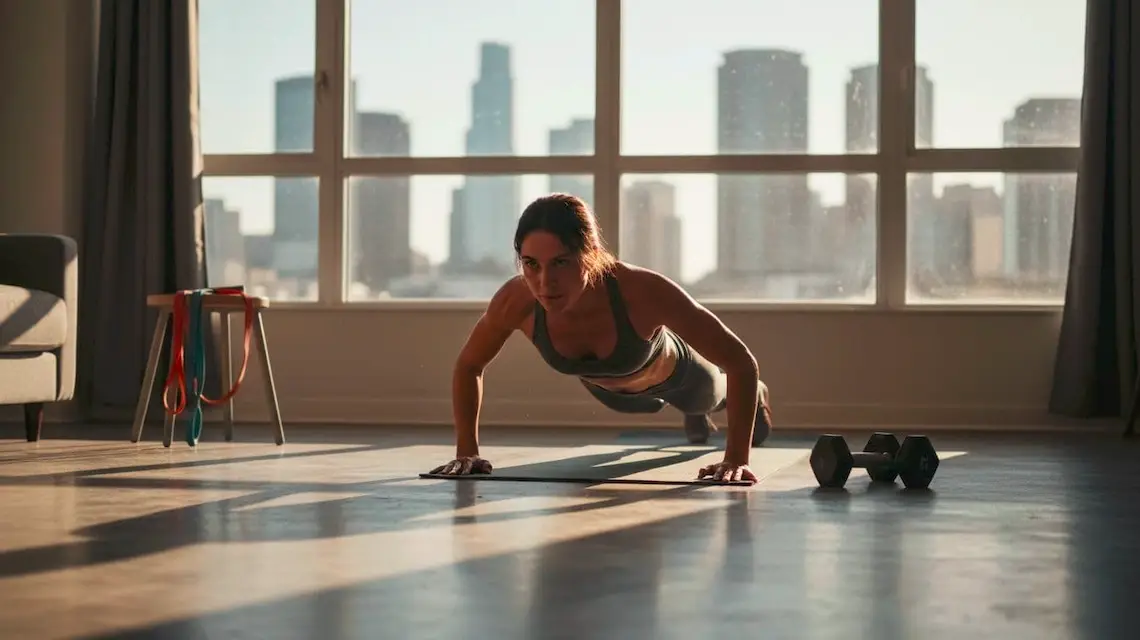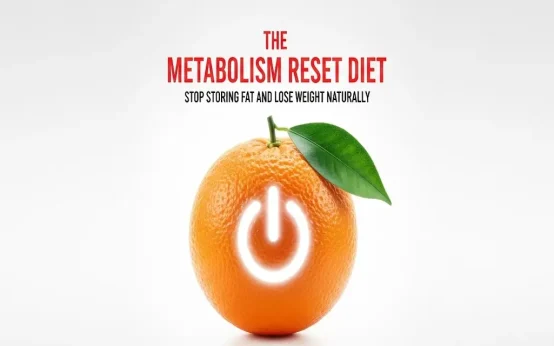What if losing weight at home felt simple, fast, and doable? You do not need a gym, fancy gadgets, or hour-long sessions to make progress. You need a smart plan, short workouts, and habits that you can keep. This guide is for beginners, busy parents, and anyone who wants clear steps without the noise.
You will get simple strength circuits, cardio ideas, and a 4 week plan that fits real life. Expect steady fat loss, about 0.5 to 1 pound per week. Strength plus simple cardio beats long, random sessions. If you want at home workouts for weight loss that you can start today, you are in the right place.
How at home workouts for weight loss work and how to set up your space
Fat loss is simple science that often gets messy. Your body burns more calories when you move more. Strength work helps you keep or build muscle, which raises how many calories you burn all day. You do not need to be perfect, you need to be consistent.
Start with one clear outcome. Pick weight loss, inches lost, or better fitness. Then choose a schedule you can keep for at least four weeks. Three strength days and two cardio days is a solid baseline. Keep workouts 20 to 40 minutes so they fit your week.
Track numbers that matter. The scale is useful, but it jumps day to day. Look at weekly trends. Use waist size, progress photos, and a strength marker like push ups. Aim for small wins that stack up, not giant swings.
Use simple tools to guide effort. Rate of Perceived Exertion, or RPE, uses a 1 to 10 scale. One is very easy, ten is all out. Most work should land around RPE 6 to 8. You should breathe harder, but still control your form.
Set your space so it invites movement. Clear one mat-sized area with good light. Keep a chair, a water bottle, and a towel nearby. Add gear over time, not all at once. The fewer barriers, the more you will train.
Warm up and cool down fast so you start and finish well.
- Warm up, 1 minute light march, 30 seconds arm circles, 30 seconds hip hinges, 30 seconds squats to chair, 30 seconds easy plank.
- Cool down, 2 to 3 minutes of slow walking and gentle stretching for hips, chest, and calves.
Fat loss made simple: calorie deficit without the math
You lose fat when you burn more energy than you take in over time. That is it. You can help this without counting every calorie. Use steady habits: eat protein at each meal, load up on veggies and fiber, drink water first, cut back on liquid calories, and stop at 80 percent full. You do not need a perfect diet to lose fat, you need steady habits that you repeat.
Set a clear goal and track progress each week
Set a four week goal you believe in. Examples:
- Lose 2 to 4 pounds.
- Complete 3 workouts per week without skipping.
- Add 2 reps to each main lift.
Track with simple tools:
- Morning weight 3 times per week, same scale.
- Waist at navel once per week, same time of day.
- A front progress photo in good light each week.
- One strength marker, like max push ups or squat reps.
Trends over weeks matter more than any single day. If your overall line moves the right way, you are winning.
Create a workout space at home on any budget
You only need a mat-sized space, a chair, and a water bottle to start. Budget friendly gear helps, but is optional. Try adjustable dumbbells or bands, a jump rope, and a step or sturdy box. No gear, no problem. Use a backpack filled with books as weight, towels as sliders, and stairs for step ups. Keep safety first, clear the floor, wear good shoes, and train in good light.
Warm up and cool down in 5 minutes
Use this quick template and keep cues simple.
- Warm up, 1 minute light march, 30 seconds arm circles, 30 seconds hip hinges, 30 seconds squats to chair, 30 seconds easy plank.
- Cool down, 2 to 3 minutes of slow walking and gentle stretching for hips, chest, and calves.
Move in ranges that feel good. Nothing should cause sharp pain. Ease in, then build intensity as warmth rises.
Beginner at home workouts for weight loss: full body strength circuits
Full body circuits hit legs, push, pull, and core in less time. They raise your heart rate, burn calories, and build lean muscle. Two options cover most homes, one bodyweight plan and one dumbbell or band plan. Work at RPE 6 to 7 so you can keep good form. Rest enough to breathe and move well.
Use these form cues across moves: keep ribs down and back flat, brace your core, and control the lowering phase. Push the floor away on squats and push ups. Keep knees tracking over toes, not caving inward. Breathe out on the hard part.
If joints feel sore, use the low impact swaps below. No move should hurt. A mild muscle burn is fine. Joint pain is not.
20 minute bodyweight circuit you can start today
Do 2 to 3 rounds. Rest 60 to 90 seconds between rounds. Keep effort at RPE 6 to 7.
- Squat to chair, 10 to 12 reps.
- Incline push up on counter, 8 to 10 reps.
- Hip hinge good morning, 12 reps.
- Reverse lunge or step back, 8 reps each side.
- Dead bug or front plank, 20 seconds.
Move smooth and steady. Stop a set if form slips. Shake out tension and reset your brace between moves.
Dumbbell or band circuit to burn more and build lean muscle
Do 3 rounds. Rest 60 seconds between rounds. Choose a load that feels like 3 reps left in the tank.
- Goblet squat, 10 reps.
- One arm row, 10 reps each side.
- Dumbbell or band press, 10 reps.
- Hip hinge deadlift, 10 reps.
- Side plank, 20 seconds each side.
Progress by adding 1 to 2 reps per set next week or a small weight jump. Keep reps smooth. If you grind or twist, the load is too heavy.
Low impact swaps for sore knees or beginners
- Sit to stand instead of deep squats.
- Step back instead of forward lunges.
- Wall push ups instead of floor push ups.
- Glute bridges instead of jumps.
- Marching high knees instead of running in place.
Choose the option that feels strong and pain free. Build range and depth over time, not all at once.
Form tips to stay safe and get more from each rep
- Keep ribs down and back flat.
- Push the floor away on squats and push ups.
- Keep knees tracking over toes.
- Brace your core like someone will poke your side.
- Breathe out on the hard part.
- Stop a set when form slips.
Quality reps beat sloppy volume. Your body will thank you later.
Cardio at home that burns fat without a treadmill
Cardio at home can be fast, joint friendly, and fun. Mix higher effort intervals with easy steady work across the week. Use RPE to guide effort so you neither coast nor overdo it. If your joints feel cranky, pick low impact options. If time is tight, keep the session short and sharp.
Use HIIT when you have 10 to 15 minutes and want a strong push. Keep it rare if you are new, one or two days per week. Use steady cardio when you want a calmer burn that is easy to recover from. Walk, step, or shadow box at a chatty pace.
Quick HIIT plan for small spaces
Work 10 to 15 minutes total. Do 30 seconds work and 30 seconds rest for 10 to 15 rounds. Choose moves like fast march, quick step taps, shadow boxing, or mountain climbers. Keep work sets around RPE 8. Beginners can do 20 seconds work and 40 seconds rest. Stay light on your feet and keep your core braced.
Indoor walking and step workouts for steady burn
Set a timer for 20 to 30 minutes. Rotate moves, march in place, side steps, grapevine steps, and stair climbs if safe. Keep effort around RPE 5 to 6. Use music and count steps. Aim for 2,000 to 3,000 steps in the session. This is joint friendly and easy to recover from, which means you can do it often.
Jump rope or shadow boxing for high calorie burn
Use short bursts for 10 to 15 minutes total. Do 30 seconds jump rope and 30 to 60 seconds rest. No rope, then shadow box with light jabs and crosses. Keep shoulders relaxed, hands up, and soft knees. If shins or knees feel sore, swap to low impact steps or a march with fast hands.
Pick the right cardio for your body and schedule
Use this simple guide:
- If joints ache, choose walking or step.
- If time is tight, pick 10 minute HIIT.
- If stress is high, do steady cardio at RPE 5.
Aim for 2 to 3 cardio days per week. Split them from strength if you can, or do cardio after strength so you lift with fresh legs.
Your 4 week at home weight loss plan: workouts, food, and recovery
You need a schedule you can stick to, not a grind you quit. Pair three strength days with two cardio days, plus one rest or mobility day. Keep sessions 20 to 40 minutes. Build slow so your body adapts. Add simple food rules and recovery habits, then let time do the heavy lifting.
Plan for progress, not perfection. Add a little work each week, then take a lighter week so you never feel fried. Keep a short checklist for meals, sleep, and steps. Small consistent actions drive big changes.
Weekly workout schedule you can stick to
Use this template:
- Monday, strength circuit.
- Tuesday, cardio 20 to 30 minutes.
- Wednesday, rest or mobility 10 minutes.
- Thursday, strength.
- Friday, cardio.
- Saturday, strength or fun active play.
- Sunday, full rest or easy walk.
Keep sessions tight so they fit real life. Short and done beats long and skipped.
Progress each week without burning out
Progress one small thing per week:
- Add 1 to 2 reps per set.
- Add about 5 percent weight.
- Add 2 minutes of cardio.
Keep one easier week every 4 weeks where you do 80 percent of normal volume. Stop a workout if pain shows up in joints. Aim for steady effort, not perfect days. Write a quick note after sessions so you see the trend.
Simple meal rules that support fat loss
Use the plate method at most meals:
- Half plate veggies or fruit.
- Quarter plate protein.
- Quarter plate carbs.
- Add a thumb of healthy fat.
Aim for 20 to 30 grams of protein each meal. Drink water before meals. Limit alcohol and sugar drinks. Plan 2 to 3 go to breakfasts and lunches so choices are easy. Example: Greek yogurt with fruit and nuts, a turkey wrap with veggies, or eggs, toast, and spinach.
Consistency tips and common mistakes to avoid
- Put workouts on your calendar like meetings.
- Lay out gear the night before.
- Use a 5 minute rule on hard days, start and keep going if it feels good.
Avoid these traps:
- Only doing HIIT and skipping strength.
- Cutting calories too low and feeling wrecked.
- Chasing sweat and soreness instead of form, reps, and consistency.
Simple habits win. Keep showing up, even when life gets messy.
Conclusion
Simple strength plus smart cardio, done at home, can drive steady fat loss. Start today with the 20 minute bodyweight circuit and one indoor walk. Next steps, set a 4 week goal, schedule 3 strength and 2 cardio days, take a waist measure and a photo. Stay patient and safe, and remember that small wins add up. Your future self will be glad you started.
Related post:
- Protein Diet and Weight Loss
- Lose Weight Fast With These Simple Tricks for a Beginning
- What Is the Best Balanced Diet to Lose Weight
- How Much Should I Walk To Lose Weight
Home Workouts That Burn Fat: Frequently Asked Questions
Do at-home workouts really help with weight loss?
Yes. You can lose weight at home if you create a calorie deficit. Pair consistent workouts with mindful eating, and you will see results.
How many days a week should I work out?
Aim for 4 to 6 days per week. Include 2 to 4 cardio sessions and 2 to 4 strength sessions, or combine them in circuits.
What are the best exercises for fat loss at home?
Use large muscle groups and compound moves. Good picks: squats, lunges, pushups, rows, hip hinges, burpees, mountain climbers, jump rope, step-ups.
Cardio or strength training, which burns more fat?
Both matter. Cardio burns more during the session, strength training preserves muscle, raises daily calorie burn, and improves shape.
How long should each workout be?
Twenty to forty minutes works well. Go shorter with higher intensity, or longer with moderate intensity.
Is HIIT better than steady-state cardio?
HIIT saves time and boosts fitness fast. Steady-state is easier to recover from and suits beginners. Mix both for the best results.
What is a simple weekly schedule I can follow?
- Mon, full-body strength, 30 minutes
- Tue, cardio or HIIT, 20 to 30 minutes
- Wed, active recovery, walk or mobility, 20 minutes
- Thu, full-body strength, 30 minutes
- Fri, cardio, 30 to 40 minutes
- Sat, optional circuit, 20 to 30 minutes
- Sun, rest
Do I need equipment?
No. Bodyweight is enough. If you want more options, add a pair of dumbbells, a resistance band, and a sturdy chair or step.
How hard should I push?
Use rate of perceived exertion. Aim for 6 to 8 out of 10 during work sets, and 3 to 4 on easy days. You should be breathing hard but still in control.
How fast will I lose weight?
A steady pace is 0.5 to 1 pound per week. That pairs well with a calorie deficit of about 300 to 500 calories per day.
What should I eat to support at-home training?
Prioritize protein, about 0.7 to 1.0 grams per pound of goal body weight. Fill the rest with fiber-rich carbs, healthy fats, and plenty of vegetables. Stay hydrated.
Can I spot reduce belly fat?
No. You lose fat in patterns set by genetics. Train your whole body, keep a deficit, and your midsection will lean out over time.
How do I warm up and cool down at home?
Warm up for 5 to 8 minutes. Use light cardio, dynamic moves, and first sets with less weight. Cool down with slow breathing and easy stretches for 3 to 5 minutes.
What if I have knee or back pain?
Pick joint-friendly swaps. Examples: step-ups or split squats instead of jump squats, hip hinges instead of sit-ups, incline pushups instead of floor pushups. If pain persists, see a clinician.
How do I avoid plateaus?
Progress one variable at a time. Add reps, sets, load, time under tension, or reduce rest. Rotate exercises every 4 to 6 weeks. Keep protein high and sleep 7 to 9 hours.
Can beginners do HIIT?
Yes, with care. Start with 10 to 15 minutes, work intervals of 20 to 30 seconds, and longer rests. Choose low-impact moves like cycling, marching, or step-ups.
What is NEAT and why does it matter?
NEAT is daily movement outside of workouts, like walking and chores. It can burn more calories than your workout. Aim for 7,000 to 10,000 steps per day if your joints allow it.
How do I track progress without a scale?
Use a mix of methods. Take waist and hip measurements, progress photos, a weekly average weight, workout logs, and a simple energy and sleep score.
Can I lose fat with only 15 minutes a day?
Yes, if you go hard and stay consistent. Try 15-minute circuits, EMOMs, or intervals. Keep rests short and form sharp.
What if I do not have much space?
Use vertical moves and in-place exercises. Think squats, lunges, pushups, planks, bear crawls, glute bridges, jump rope in a doorway, shadow boxing.
Should I train fasted?
You can, if it feels good. For intense sessions, a small snack with carbs and protein 60 to 90 minutes before often helps performance.
How important is sleep for fat loss?
Very. Poor sleep raises hunger and lowers training output. Aim for 7 to 9 hours, keep a dark room, and cut screens before bed.
How do I stay motivated at home?
Set clear, short goals, like three workouts per week for four weeks. Put sessions on your calendar. Use a simple program, track wins, and reward consistency, not perfection.
When should I see a doctor before starting?
If you have heart, lung, or metabolic conditions, are pregnant or postpartum, or have ongoing pain, get medical clearance. Start slow and progress with intent.




 How to Start a Weight Loss Program
How to Start a Weight Loss Program  What Vitamin Deficiency Makes It Hard to Lose Weight?
What Vitamin Deficiency Makes It Hard to Lose Weight?  Improve Fat Burning With a Metabolism Reset Diet
Improve Fat Burning With a Metabolism Reset Diet  How to Avoid Loose Skin When Losing Weight
How to Avoid Loose Skin When Losing Weight  Good Eating Habits for Weight Loss
Good Eating Habits for Weight Loss  A Guide to Weight Loss for Busy People in Today’s Society
A Guide to Weight Loss for Busy People in Today’s Society